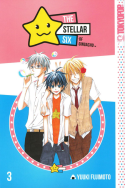By Yuuki Fujimoto. Released in Japan as “Kirameki☆Gingachou Shoutengai” by Hakusensha, serialized in the magazine Hana to Yume. Released in North America by Tokyopop.
And so sadly we come to the end of this series in North America. I’m not optimistic about any license rescues, so it looks as if Volumes 4-10 will only be available in Japanese for the foreseeable future. Which is a shame, as this is a great volume of slice-of-life shoujo manga, and we’re finally starting to see at least one of the four other friends get some development.
The last volume of this series seems to have only come out via Diamond Distribution’s comic book stores – Amazon and Right Stuf never shipped it. Indeed, it was very hard to find any cover art at all that didn’t have ‘art not final’ stamped on it.
As for the volume itself, thankfully there seems to be only one of the ‘Mike wants everyone to be best friends 4-evah’ type of story we saw so often in the first two volumes. This leaves us with more regarding the relationship between Mike and Kuro. Mike is mostly as dense as ever (Q even tries hugging her close to show that she only feels ‘weird’ about it when Kuro does it, though this backfires on him spectacularly), but after the final story where she cheerfully agrees to go on a date with another guy without realizing what it actually is, she seems to at least start to get the idea that life is not all about happy smiles and that eventually real love and affection is going to have to come into play.
The character who gets the best focus here is Sato, the shy wallflower girl of the six friends. She’s at a different school from the others, and doesn’t stand out as much among the insane eccentrics in her group, so not only is she feeling depressed and inadequate, other kids are talking about her as the odd one out. Naturally, they stick her with the class rep job, the traditional job given in manga to the last person who wants it. Nothing unique or surprising happens here – with the help of her friends who show her that they love her no matter what, she’s able to overcome her fears and worries – but it’s still a heartwarming story nonetheless.
Mike and Kuro have been the focus of the romance to date, so it’s intriguing to see that we may be seeing the other four get in on the act. Kuro drags Sato along to pose as his date while he stalks Mike on hers, which shows that in many ways he can be Mike’s equal in cluelessness, as we note that she seems to have a crush on him. More intriguingly, in the funniest chapter of the book, where the three boys are candidly snapped for a gossip magazine and then become local ‘hottie’ celebrities, we get Kuro implying Q also has a crush. Indeed, Kuro’s angry “Mr. Eternally Unrequited Love” gets Q rather annoyed, and clearly it’s a plot point we would learn more about in future volumes were they coming out.
As I noted when I reviewed Happy Cafe, this type of shoujo manga is something we saw quite a bit of from CMX and Tokyopop but less from Viz. As a result, I suspect we won’t be seeing much of this genre, the manga where romance is there but not the focus, and you end up simply smiling at reminiscence of those happy childhood/teenage memories. Despite my above cynicism, I do hope that one day we find out how Mike and Kuro will get together, and see if the other four also find happiness (with each other? Well, it is that type of manga, so I wouldn’t be surprised). Try to track down a copy of this if you can.
